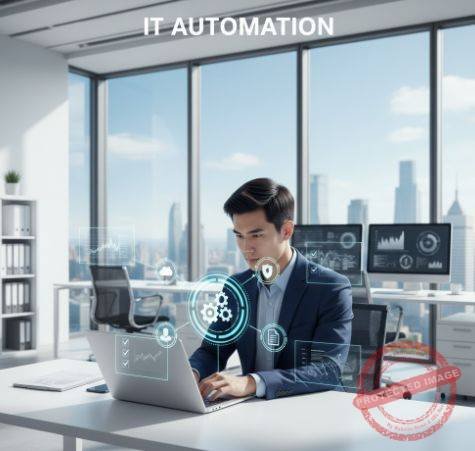As enterprises scale cloud, microservices, and distributed systems, AI-powered automation becomes essential — enabling predictive remediation, autonomous workflows, and self-healing infrastructure.
Autonomous operations becomes reality
For years, IT automation focused on scripted workflows, runbooks, and scheduled tasks. But in 2025, the story shifts dramatically: AI-driven IT automation, or AIOps-enabled autonomous operations, has moved from experimental pilots to mainstream adoption.
With cloud complexity doubling, container density rising, and hybrid infrastructures becoming the norm, IT teams can no longer rely on manual intervention. Instead, automation systems now predict issues, generate remediation steps, and execute them automatically, cutting downtime and dramatically improving service reliability.
Vendors are positioning autonomous operations not as an optional add-on, but as the next evolution of infrastructure management.
The drivers accelerating AI automation
1. Exponential telemetry growth
Modern platforms ingest millions of log lines per minute, traces from hundreds of microservices, and real-time metrics across compute, storage, and network layers. Humans cannot meaningfully process this volume of data. AI models detect anomalies, correlate signals, and surface root causes instantly.
2. Cloud cost pressure
Budgets are tightening, and AI automation identifies waste (idle nodes, oversized clusters, redundant VMs) and triggers cost-saving actions. This continuous optimization replaces periodic manual cleanups.
3. Talent shortage in SRE and DevOps
Automation platforms now handle repetitive tasks — node restarts, cache refreshes, scaling actions — so engineers can focus on architecture, reliability, and business value.
4. AI model maturity
Large language models (LLMs) and machine-learning-based pattern analysis give automation platforms a deeper understanding of “normal vs abnormal,” reducing false positives and enabling safe self-healing actions.
AIOps: the automation brain
Today’s AIOps platforms combine:
-
Anomaly detection (time-series modeling, seasonality prediction)
-
Event correlation across logs, traces, and metrics
-
Generative RCA that explains incidents in plain language
-
Automated action pipelines that reboot services, scale clusters, rotate secrets, or modify configurations
These systems don’t just alert — they act.
From detection to autonomous remediation
Modern workflows automatically:
-
Restart unhealthy pods
-
Clear stale cache entries
-
Shift workloads to healthy nodes
-
Patch vulnerable configurations
-
Roll back releases if error budgets breach
-
Regenerate access tokens or secrets
Each action is logged, audited, and tied back to service-level objectives (SLOs) to ensure governance.
IT automation meets LLMs
The integration of LLMs with operations telemetry is transforming automation capabilities.
LLM-generated runbooks
Instead of writing runbooks manually, LLMs analyze historical incidents and auto-generate:
-
Step-by-step remediation instructions
-
Troubleshooting guides
-
Knowledge-base articles
-
Service behavior summaries
These documents auto-update as new data arrives.
Conversational automation
Ops teams can now issue commands via natural language:
-
“Scale checkout service by 20%.”
-
“Rotate Redis cache keys in staging.”
-
“Show me the last 5 anomalies for the API gateway.”
LLMs convert this into executable automation actions with full validation and approval flows.
Governance becomes essential
As more tasks become autonomous, governance frameworks mature:
-
Permissions and guardrails define what AI can do without approval.
-
Policy-aware automation ensures compliance (SOC2, ISO, PCI).
-
Audit trails log every AI-initiated action.
-
Risk scoring determines whether human review is needed.
This keeps automation safe, compliant, and accountable — especially in regulated industries.
Real-world use cases delivering value
1. Cloud optimization
AI detects oversized clusters, identifies unused services, and rightsizes workloads automatically — reducing cloud spend by 15–40% in many enterprises.
2. Incident auto-remediation
Over 60% of repetitive incidents (pod crashes, stuck deployments, disk-pressure warnings) can now be resolved without human intervention.
3. CI/CD automation
AI validates pull requests, checks dependency vulnerabilities, predicts regressions, and halts bad builds prior to deployment.
4. Security automation
Threat detection tools now issue automated containment actions: quarantining suspicious VMs, rotating credentials, blocking IPs, and validating signatures.
The challenges ahead
Black-box decisioning
Teams worry about explainability — why an AI took (or didn’t take) a remediation action.
False positives
Improperly tuned models can generate unnecessary restarts or shutdowns.
Over-automation risk
Relying too heavily on automation may cause skill atrophy in operational teams.
Integration complexity
Legacy systems require custom adaptors before they can participate in autonomous workflows.
What mature AI-first automation looks like
By 2026, leading organizations will have:
-
A unified observability + automation platform
-
Predictive scaling based on user behavior and seasonality
-
Cross-cloud orchestration balancing workloads in real time
-
Self-healing clusters with zero manual restarts
-
LLM-generated documentation keeping knowledge fresh
-
Cost, risk, and performance dashboards tied directly to automation actions
The line between observability and automation will blur — IT systems will increasingly manage themselves.
Closing thoughts
AI-driven IT automation is no longer a future concept; it is the new operating model for enterprise IT. Teams that embrace autonomous operations will reduce downtime, improve reliability, lower costs, and dramatically accelerate engineering velocity. The next frontier is predictable, explainable, policy-driven automation that connects every layer of the digital ecosystem into a self-optimizing engine.
Reference sites (5)
Publication: Gartner
Topic: Market Guide for AIOps Platforms
URL: https://www.gartner.com/document/aiops-market-guide
Publication: IBM Research Blog
Topic: The Evolution of AIOps and Autonomous Infrastructure
URL: https://research.ibm.com/blog/aiops-autonomous-infrastructure
Publication: Dynatrace Blog
Topic: AI-Powered Operations with Davis AI
URL: https://www.dynatrace.com/news/blog/aiops-davis-ai/
Publication: ServiceNow Blog
Topic: Automating IT Workflows with GenAI
URL: https://www.servicenow.com/blogs/2025/automating-it-with-genai.html
Publication: Cisco DevNet
Topic: Self-Healing Infrastructure with Predictive Automation
URL: https://developer.cisco.com/blog/self-healing-infrastructure/
Author:
Serge Boudreaux — AI Hardware Technologies, Montreal, Quebec
Peter Jonathan Wilcheck — Miami, Florida
Post Disclaimer
The information provided in our posts or blogs are for educational and informative purposes only. We do not guarantee the accuracy, completeness or suitability of the information. We do not provide financial or investment advice. Readers should always seek professional advice before making any financial or investment decisions based on the information provided in our content. We will not be held responsible for any losses, damages or consequences that may arise from relying on the information provided in our content.



